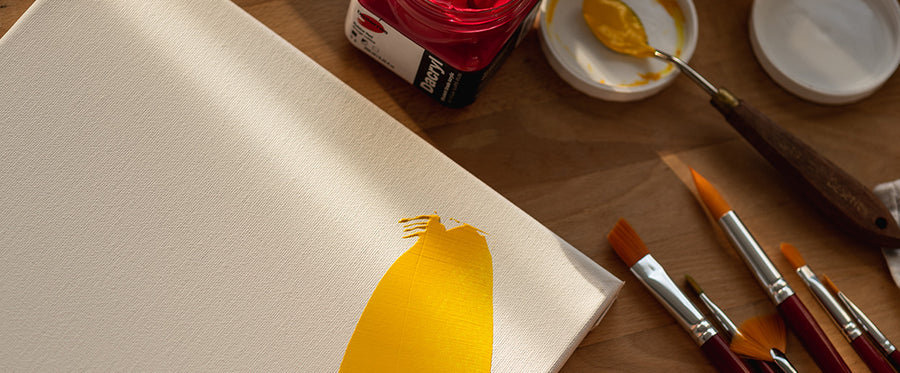Quality first

Above all, it's important to choose a good quality acrylic. High-quality acrylics offer better pigmentation, very good adhesion and greater durability than student-quality paints.
If you're on a tight budget, I recommend using a lower quality paint; however, without compromising on your basic colours. If possible, steer clear of cheap acrylic paints or wall paints.
5 types of acrylic paint

Acrylic paints dry quickly, which can be an advantage or a disadvantage depending on how you work. They can be diluted with water for more transparency, or mixed with mediums to slow down drying or create different effects.
Acrylic paints come in different consistencies: liquid, fluid, medium and high density. Each consistency is suitable for different types of projects, so I recommend that you have fun exploring them! To help you explore, here are the five main types of paint:
1) High Viscosity/Heavy Body
High viscosity acrylics are perfect for painters looking for a professional quality paint with an exceptionally smooth, thick and creamy consistency. This type of High Viscosity (Liquitex) or Heavy Body (Golden) finish allows for exceptional colour blends, as well as volume and texture effects.
2) Fluid/Soft Body
Somewhere between High Viscosity (dense consistency) and High Flow (liquid consistency), Fluid (Golden) and Soft Body (Liquitex) acrylics can be applied in layers to create transparency and depth, while maintaining colour intensity and good adhesion.
3) High Flow
This liquid acrylic paint, developed by Golden, acts like ink when wet, but like regular acrylic paint when dry. Perfect for painting details with a brush, this paint is also great for illustrations and very fine details, as well as for wash techniques. This type of paint is suitable for a variety of techniques, including calligraphy, airbrushing and mixed media.
4) So Flat
With its fluid, viscous consistency, Golden's So Flat dries to a matte finish, with excellent coverage and low transparency. This type of paint is ideal for creating finishing details and drawing precise lines.
5) Open
Open is a revolutionary range of slow-drying acrylic paints. This means they can be used for traditional techniques that are only possible with oil paints.
Open paints stay wet for extended periods and are ideal for painting outdoors, or for screenprinting techniques.
Choosing the right finish

When it comes to choosing the right paint, it's just as important to choose the right finish. Colour vibrancy can have a huge impact on the outcome of your project! Choosing the right finish depends above all on the type of surface you want to cover. Why, you ask? Because each finish has unique characteristics that are best suited to a given surface. So, without further ado, here are the different finishes offered by acrylic paint:
1) Opaque
Opaque acrylic paint completely covers the underlying surface. It's often used to create solid, opaque layers of colour, without revealing what's underneath. Opacity or transparency levels are indicated on paint tubes or bottles.
2) Semi-transparent
This type of acrylic paint lets a little light through, allowing you to see some of the underlying layers. It can be used to create layering and depth effects.
3) Translucent
Translucent acrylic paint is virtually transparent, allowing you to see almost all underlying layers. It's often used for glazing effects, to blend colours smoothly, or to create subtle highlights. With varying levels of transparency, artists can create different visual effects and express their creativity in numerous ways.
The different brands

There are many brands of acrylic paint. I regularly work with these three brands: Golden, Liquitex and Dacryl (DeSerres's house range). These brands are easy to find, both in stores and online.
Acrylic paint brands must comply with colour naming standards. This means that the name of a colour, such as Primary Magenta, will generally be the same from one brand to the next, ensuring consistency in colour naming. However, the pigments used may vary slightly. These differences may affect the hue, saturation or other properties of the colour.
Given that acrylic paint is so versatile, flexible and ultra-resistant, I like to experiment by combining pigments from different brands. However, I recommend the best quality for primary and secondary colours, as well as black and white.
To conclude
The key to choosing the right acrylic paint is to experiment by using different types, as well as combining different techniques and surfaces. Exploration and practice are essential to mastering acrylic painting and developing your own style. Now, you’re ready to dive into the wonderful world of acrylic painting … and don’t forget to have fun!










